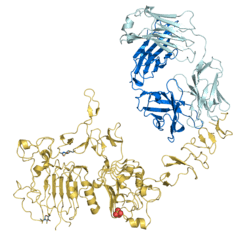SKBR3
SkBr3 (also known as SK-BR-3) is a human breast cancer cell line isolated by the Memorial Sloan–Kettering Cancer Center in 1970 that is used in therapeutic research, especially in context of HER2 targeting.[1]
History and characteristics

SkBr3 cells were derived from a pleural effusion due to an adenocarcinoma originating in a 43-year-old caucasian female.[1] The cell line over-expresses the HER2 gene product, which has been implicated in several breast cancer proliferation pathways. The SkBr3 cell line is autologous (derived from the same patient) with the AU565 cell line.[2] The cells are considered biosafety level 1. They are known to grow in grape-like clusters with an invasive phenotype resembling that of the cells in vivo.[3]
Research applications
SkBr3 cells have been used in studies seeking to overcome Herceptin resistance to HER2-overexpressing breast cancers.[4] The cell line has also been examined for applications in CRISPR/Cas9 gene editing,[5] antibody resistance in transfections, and HER2-based cancer therapies in context of microenvironment fluctuations.[6]
See also
References
- "SK-BR-3: Human Breast Cancer Cell Line (ATCC HTB-30)". Memorial Sloan-Kettering Cancer Center. Retrieved 18 June 2018.
- "SK-BR-3 cells". Addex Bio. Retrieved 18 June 2018.
- Holliday, Deborah L; Speirs, Valerie (12 August 2011). "Choosing the right cell line for breast cancer research". Breast Cancer Research. 13 (215): 215. doi:10.1186/bcr2889. PMC 3236329. PMID 21884641.
- Tseng, Ping-Hui; et al. (November 2006). "Overcoming Trastuzumab Resistance in HER2-Overexpressing Breast Cancer Cells by Using a Novel Celecoxib-Derived Phosphoinositide-Dependent Kinase-1 Inhibitor". Molecular Pharmacology. 70 (5): 1534–1541. doi:10.1124/mol.106.023911. PMID 16887935.
- Cao, Jian; et al. (2 November 2016). "An easy and efficient inducible CRISPR/Cas9 platform with improved specificity for multiple gene targeting". Nucleic Acids Research. 44 (19): e149. doi:10.1093/nar/gkw660. PMC 5100567. PMID 27458201.
- Weigelt, Britta; et al. (1 July 2011). "HER2 signaling pathway activation and response of breast cancer cells to HER2-targeting agents is dependent strongly on the 3D microenvironment". Breast Cancer Research and Treatment. 122 (1): 35–43. doi:10.1007/s10549-009-0502-2. PMC 2935800. PMID 19701706.